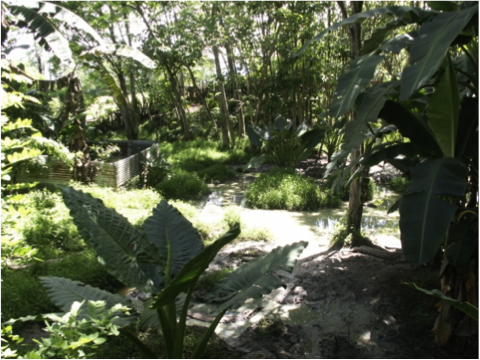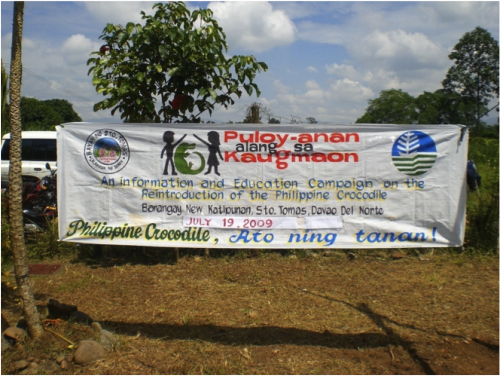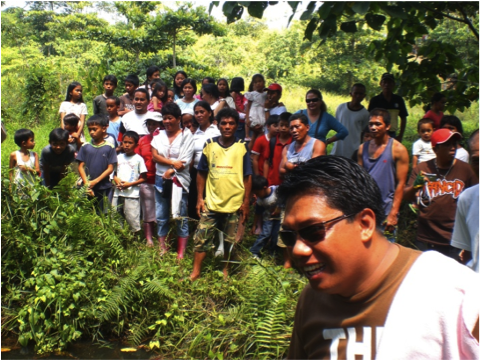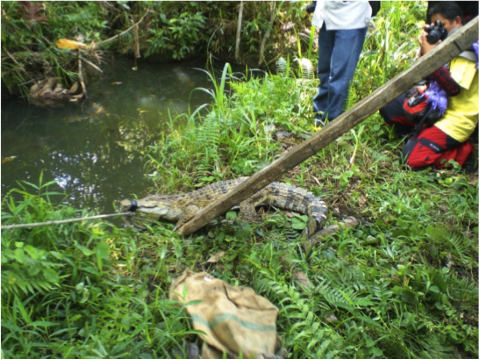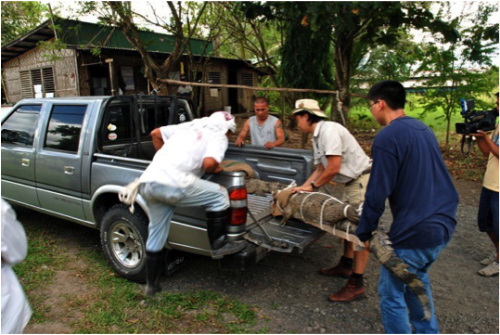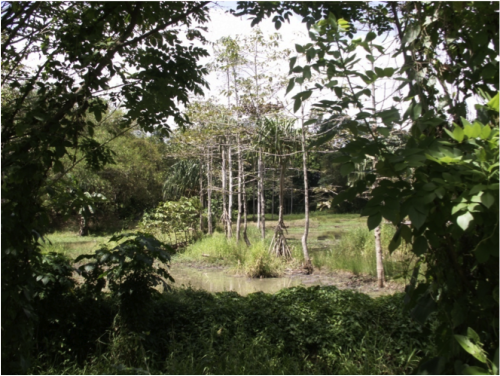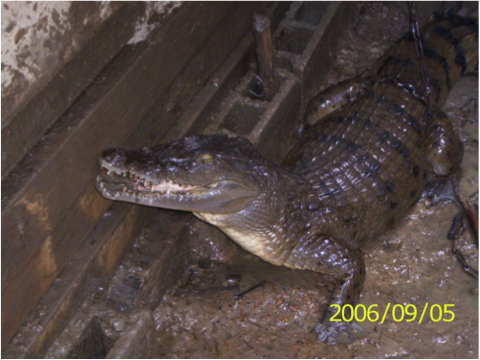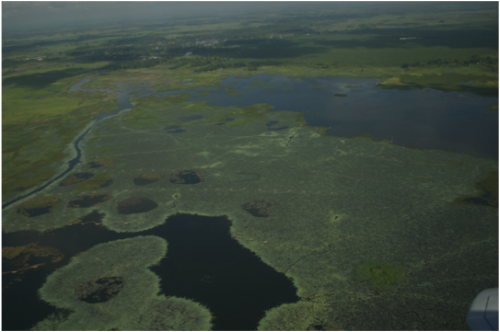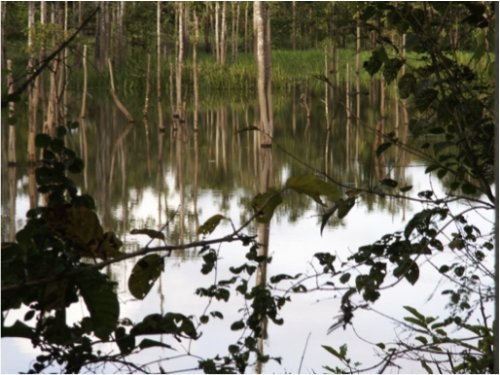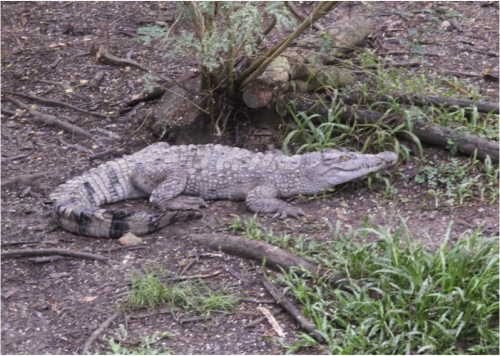In 2006 Pag-Asa Farms, Davao, decided to become involved with C. mindorensis conservation ancillary to its commercial Crocodylus porosus farming activities. At that time 2 female C. mindorensis and 10 other individuals were obtained from Silliman University and PWRRC respectively. These were released in a semi-natural pen (above right) and successful nesting was recorded soon afterward (nest site. Above left).
Soon after release into these pens, at the suggestion of Dr. Alcala, all human interaction with these crocodiles ceased and the animals foraged and socialized by themselves eating rails, rats, snakes and other foods they were able to catch until release of 3 individuals in 2009.
There are no records of wild C. mindorensis from this area although they likely did exist at one time. As such we consider this an introduction – not a re-introduction.
Education and Information Campaign
Before release of crocodiles it was necessary to obtain barangay resolutions and other administrative papers. Students from UP Diliman and Pag-asa staff, with financial support of the Forum on Crocodiles in the Philippines and Pag-asa, spent a month meeting with all possible stake holders – but especially those living in direct contact to crocodile release areas. Even this was not enough to convince some farmers that they could co-exist with the released animals.
Release
Initially three crocodiles were released. The farmers approved of having the crocodiles on their property as they noticed the rice rat population had decreased. However, as rice planting started they noticed and complained about damage to young plants by the wanderings of the crocodiles. Two individuals were removed.
Subsequently Kim Atienza filmed a TV segment on release of C. mindorensis at Pag-asa and another 2 individuals were released. These animals appear to have migrated to a more remote part of the marshland.
There have been no recent complaints about crocodiles, nor, any “Human Crocodile Interactions”. The farmers also know that they can contact Pag-asa at any time to rectify conflicts.
Lessons Learned from a Unique Experiment
Most so-called re-introduction schemes rely on release sites that are still in a relatively wild condition. At Pag-asa crocodiles are being released into agricultural lands with pockets of marsh. There are many more possibilities of finding these habitats – and not relying on a non-functional park and reserve system.
Three components were found critical:
EIC – the meeting with individuals, schools, barangay’s, Municipal organizations. Including the role of crocodiles in the ecosystem.
Contact – that the stake holders know that there are people who can respond to problems or concerns quickly.
Adaptation – using crocodiles that are not used to human interaction, especially feeding, that can forage for themselves and are SCARED of people.,
Population Supplementation of Crocodulus mindorensis in Ligawasan March, Cotabato
During the Ligawasan field surveys of 2006 – 2007 conducted by K. Pomares and students at University of Southern Mindanao, a small number of captive – adult C. mindorensis were identified mostly in back-yard pens and cages. Several of these crocodiles were offered to the team at no cost, but this activity had not been budgeted and the there were no facilities to keep the animals.
In 2011 the Ligawasan Crocodile Rescue and Breeding Center was established by USM and the Cotabato Govt. by building two semi-natural pens in the Government Compound with financial assistance of Samut Prakarn Crocodile Farm, Thailand, Chris Banks, and CSG (through an anonymous donor). Funding coursed thru CPPI.
Concept and Implementation
The plan is to use crocodiles known to be native to the Ligawasan region that have already been removed from the wild population (for various reasons) and are not contributing to the well being of the species. It is hoped to breed some of these crocodiles and the resulting young will be released in a culturally protected area (at an age of 2 – 3 months). Monitoring in this area will not be possible under today’s conditions.
No payment will be made for the crocodiles or care in the wild. A small stipend for an animal caretaker will be supplied by the Provincial Government. The young crocodiles being released will be kept in a semi-natural enclosure and left to fend for themselves until released.
The lack of payment is critical. It indicates to potential “poachers” that the crocodiles have no monetary value. The project should be self supporting within 2 years.
Siargao Island
Dr. Diesmos will present a more detailed summary of the proposed Siargao Id. C. mindorensis introduction initiative endorsed by CPPI.
Although the area of the introduction is sparsely populated, during extensive rains the marshland does overflow into active agricultural habitats. As such a very widespread and detailed EIC is necessary to assess public reaction.
Also, the farmers and fishers in the release area are not used to crocodiles and are mostly new immigrants. It is only in the coastal regions with C. porosus that the humane-crocodile interaction seems well tolerated.
Introduction
The initiative is five pronged. Failure of any one item will mark the success of the introduction.
EIC. A detailed and thorough EIC is necessary – not at the Municipal level but at the Barangay and Sitio level. In most instances dealing with the mayors of the pertinent towns will not be of any real help.
Assessment. This activity will be conducted by the NMP and should indicate food species available to the crocodiles.
Contact Point. A person needs to be designated and partially funded for the first several years to be available should any negative human-crocodile interaction take place. This is critical!
That crocodiles released in the area are not accustomed to human – i.e.., dependant on people for food.
That the project becomes self sufficient in a short period of time. Again, EIC and Development/Natural History students can help. Some ideas are already proposed and future island development can not be foreseen without Eco-infrastructure.
Criteria necessary for introduction of a species vs. reintroduction vs. supplementation.
Under the guidelines presented by IUCN, and paraphrased by Banks and Rebong, there are no RE-INTRODUCTIONS of C. mindorensis occurring or planned in Mindanao at this time. At Pag-asa and Siargao there are no historical records of the species and no similar crocodiles occur in the vicinities.
As such several of the criteria such as genetic issues – in this instance the nuance of parentage is minor as there is no existing stock on site and similarly with disease – if there are no other crocodiles to spread it to, really do not apply to these scenarios.
With the Ligawasan release project the progeny are known to have come from local crocodiles and as such genetics is mute. If the crocodile looks and acts healthy at 2 or 3 months of age and is living in a condition without supplement by humans – it is likely healthy.
skip to main |
skip to sidebar

The Cabana is available for wedding receptions, company meetings, birthday parties, and any other occasion. Please contact the office for more info.
Cabana

The Cabana is available for wedding receptions, company meetings, birthday parties, and any other occasion. Please contact the office for more info.


